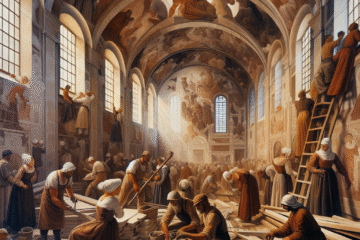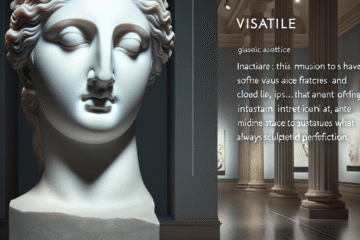I. Introduction
Art has always played a significant role in shaping societal norms and values. From ancient times to modern day, art has been used as a reflection of cultural values, a tool for challenging the status quo, and a means of promoting social change. The impact of art on society can be seen in the way it reflects, challenges, and shapes our collective beliefs and values.
The relevance of this topic is clear in the current global climate. As societies become more diverse and interconnected, the role of art in shaping cultural norms and values becomes even more crucial. The influence of art is not limited to the individual, but can have a significant impact on the way we view ourselves, our communities, and the world around us. As such, it is important to understand how art can be used to create positive change, and how it can be leveraged to promote cultural understanding and acceptance.
In this article, we will explore the multifaceted role of art in shaping societal norms and values. We will begin by discussing the concept of art as a reflection of cultural norms and values, highlighting how art can serve as a powerful mirror of our collective beliefs and ideals. From there, we will explore the ways in which art can be used to challenge the status quo and promote social change. We will examine notable examples of artworks that have challenged societal norms and values, from classical works of art to modern-day pieces.
Next, we will delve into the ways in which art can be used to shape societal norms and values. We will discuss how artists can use their work to inspire change and shape cultural beliefs, drawing on examples from various artistic mediums. Finally, we will examine the impact of technology on the role of art in shaping societal norms and values. We will explore how technology has changed the way we consume and create art, and the potential impact of these changes on the role of art in shaping our cultural landscape.
By exploring the multifaceted role of art in shaping societal norms and values, we hope to demonstrate the ongoing relevance of art in promoting cultural understanding, acceptance, and positive change. Through the lens of art, we can gain a deeper understanding of the complexities of our society, and work to create a more equitable and just world for all.
II. Art as a reflection of societal norms and values
Art is a powerful tool that can be used to reflect the cultural norms and values of a society. Throughout history, artists have used their work to mirror the beliefs, values, and ideals of their time. By examining the art of a particular era or culture, we can gain valuable insights into the societal norms and values of that time. In this section, we will explore the concept of art as a reflection of societal norms and values, and highlight some examples of artworks that reflect these values.
Art as a reflection of societal norms and values
Art is not created in a vacuum. It is shaped by the beliefs, values, and ideals of its creator and the society in which it is produced. As such, art can provide a unique insight into the cultural norms and values of a particular era or culture. Art can reveal the aspirations, fears, and attitudes of a society, and can offer a window into the collective psyche of a people.
Artworks can reflect a wide range of cultural norms and values, from religious beliefs to political ideologies, social structures, and moral codes. For example, the art of the Renaissance period was heavily influenced by the dominant religious beliefs of the time, with religious themes and iconography appearing in many works of art. Similarly, the art of the Romantic period reflected the social and political upheaval of the time, with many artists using their work to challenge the established social and political norms of the day.
Examples of artworks that reflect societal norms and values
One of the most famous examples of art as a reflection of societal norms and values is the painting “The Last Supper” by Leonardo da Vinci. This painting is widely regarded as a masterpiece of Renaissance art and reflects the religious beliefs and values of the time. The painting depicts the final meal shared by Jesus and his disciples before his crucifixion, and the image of Christ and his disciples has become an enduring symbol of Christianity.
Another example of art reflecting societal norms and values is the painting “Olympia” by Edouard Manet. This painting caused a scandal when it was first exhibited in 1865 due to its depiction of a nude woman, which was seen as a challenge to the established social and moral codes of the time. The painting reflects the changing attitudes towards sexuality and the female body that were taking place in France during the mid-19th century.
In contemporary art, the work of the artist Ai Weiwei is a notable example of art as a reflection of societal norms and values. Ai Weiwei’s work often critiques the Chinese government and its policies, highlighting issues such as corruption, censorship, and human rights violations. His work reflects the growing dissatisfaction with the Chinese government among many young people in China, and the desire for greater transparency and accountability.
Conclusion
Art has the power to reflect the beliefs, values, and ideals of a society, offering a unique insight into the collective psyche of a people. Artworks can reveal a wide range of cultural norms and values, from religious beliefs to political ideologies, social structures, and moral codes. By examining art as a reflection of societal norms and values, we can gain a deeper understanding of the historical and cultural context in which it was produced, and the ways in which it has shaped our world.
III. Art as a tool for challenging societal norms and values
Art has long been used as a tool for challenging societal norms and values. From provocative paintings to controversial sculptures, art has the power to push against the status quo and promote social change. In this section, we will explore the concept of art as a tool for challenging societal norms and values, and highlight some examples of artworks that have challenged these values.
Art as a tool for challenging societal norms and values
Artists have always used their work to express their personal beliefs and challenge the established social and cultural norms of their time. Art can be used to challenge the status quo and promote social change by providing a platform for marginalized voices, drawing attention to important social issues, and inspiring people to take action.
Art can also challenge societal norms and values by pushing the boundaries of what is considered acceptable or appropriate. By creating provocative or controversial works of art, artists can generate public debate and create space for new ideas and perspectives.
Examples of artworks that have challenged societal norms and values
One of the most famous examples of art challenging societal norms and values is the painting “Guernica” by Pablo Picasso. This painting was created in response to the bombing of the Spanish town of Guernica during the Spanish Civil War. It depicts the horrors of war and the suffering of innocent civilians, challenging the glorification of war that was prevalent in many societies at the time.
Another example of art challenging societal norms and values is the performance art of the feminist artist Marina Abramović. Abramović’s work often explores the themes of gender and sexuality, and challenges the traditional roles of women in society. Her performance art pieces have included self-mutilation, nudity, and other taboo subjects, provoking strong reactions from audiences and critics alike.
In contemporary art, the work of the street artist Banksy is a notable example of art as a tool for challenging societal norms and values. Banksy’s work often critiques consumerism, capitalism, and other aspects of modern society that he sees as oppressive or unjust. His artworks have been used to draw attention to issues such as police brutality, immigration, and environmental degradation.
Conclusion
Art has the power to challenge the established social and cultural norms of our time, promoting social change and inspiring people to take action. Art can challenge societal norms and values by providing a platform for marginalized voices, pushing the boundaries of what is considered acceptable or appropriate, and generating public debate around important social issues. By examining art as a tool for challenging societal norms and values, we can gain a deeper understanding of the ways in which artists use their work to inspire change and promote social justice.
IV. Art as a way to shape societal norms and values
Art is not only a reflection of societal norms and values or a tool for challenging them, but it can also shape and influence them. Throughout history, artists have used their work to shape cultural beliefs and values, offering new perspectives and ideas that challenge the dominant paradigms of their time. In this section, we will explore the concept of art as a way to shape societal norms and values and highlight some examples of artworks that have helped shape these values.
Art as a way to shape societal norms and values
Art has the power to shape societal norms and values by influencing the beliefs and attitudes of individuals and communities. Through their work, artists can challenge established cultural norms and values, and offer new perspectives and ideas that can lead to social change. Art can be used to educate, inform, and inspire, creating a platform for social transformation and progress.
Artists can use a variety of techniques and mediums to shape societal norms and values, from painting and sculpture to film, music, and performance art. By exploring new forms of expression and pushing the boundaries of what is considered acceptable or appropriate, artists can inspire social change and shape the cultural landscape of their time.
Examples of artworks that have helped shape societal norms and values
One of the most influential examples of art shaping societal norms and values is the work of the Pop Art movement in the 1960s. Pop artists, such as Andy Warhol and Roy Lichtenstein, used their work to critique the consumerist culture of the time, challenging the notion that material goods could provide a sense of fulfillment or happiness. Their work helped to shape a new cultural paradigm that placed greater value on personal experiences and human connection.
Another example of art shaping societal norms and values is the music of Bob Dylan. Dylan’s music was a major influence on the civil rights and anti-war movements of the 1960s, with songs such as “Blowin’ in the Wind” and “The Times They Are A-Changin'” becoming anthems for social change. His work helped to shape the cultural values of the time, inspiring a generation of young people to challenge the established social and political norms of their day.
In contemporary art, the work of the artist JR is a notable example of art shaping societal norms and values. JR’s large-scale photographic installations challenge traditional notions of art by creating site-specific works that engage with the communities in which they are installed. His work explores issues such as immigration, poverty, and human rights, and has helped to shape the cultural values of communities around the world.
Conclusion
Art has the power to shape societal norms and values by influencing the beliefs and attitudes of individuals and communities. Through their work, artists can challenge established cultural norms and values, and offer new perspectives and ideas that can lead to social change. By exploring new forms of expression and pushing the boundaries of what is considered acceptable or appropriate, artists can inspire social change and shape the cultural landscape of their time. By examining art as a way to shape societal norms and values, we can gain a deeper understanding of the ways in which art can be used to create positive change and shape the cultural values of our society.
V. The impact of technology on the role of art in shaping societal norms and values
Technology has had a significant impact on the way we consume and create art, and this has changed the role of art in shaping societal norms and values. From digital art to virtual reality experiences, technology has opened up new avenues for artistic expression and expanded the reach of art beyond traditional gallery spaces. In this section, we will explore the impact of technology on the role of art in shaping societal norms and values.
The impact of technology on the consumption of art
One of the most significant impacts of technology on the role of art in shaping societal norms and values is the way we consume art. The rise of digital media has made it possible for people to access art from all over the world, without the need to visit physical galleries or museums. This has democratized the consumption of art, making it more accessible to people from diverse backgrounds and cultures.
The accessibility of digital media has also expanded the reach of art beyond traditional spaces. Social media platforms like Instagram and Facebook have become important channels for artists to showcase their work and engage with audiences. These platforms have created new opportunities for artists to connect with communities and create meaningful conversations around important social issues.
The impact of technology on the creation of art
Technology has also had a significant impact on the way art is created. Digital tools have made it possible for artists to explore new forms of expression, and to create works that push the boundaries of what is considered traditional art. For example, the rise of digital art has created new opportunities for artists to work with interactive installations, virtual reality experiences, and other forms of immersive media.
The use of technology in the creation of art has also opened up new possibilities for collaboration and innovation. For example, artists can now collaborate with scientists, engineers, and other professionals to create works that explore the intersections of art, technology, and science. This has created new opportunities for artists to engage with emerging technologies and to explore the impact of technology on society.
The impact of technology on the role of art in shaping societal norms and values
The impact of technology on the role of art in shaping societal norms and values is complex. While technology has created new opportunities for artistic expression and expanded the reach of art beyond traditional spaces, it has also raised questions about the authenticity and value of digital art. Additionally, the use of social media platforms to showcase art has led to concerns about the commodification of art and the impact of consumerism on the artistic process.
Furthermore, the use of technology in the creation of art has raised questions about the role of the artist in shaping societal norms and values. While technology has created new opportunities for artists to engage with emerging technologies and to explore the impact of technology on society, it has also raised concerns about the role of technology in shaping our cultural values and beliefs.
Conclusion
Technology has had a significant impact on the role of art in shaping societal norms and values. The accessibility of digital media has democratized the consumption of art and expanded the reach of art beyond traditional spaces. The use of technology in the creation of art has created new opportunities for artistic expression and innovation, and has raised questions about the role of the artist in shaping our cultural values and beliefs. By examining the impact of technology on the role of art in shaping societal norms and values, we can gain a deeper understanding of the ongoing relevance of art in our changing world.
VI. Conclusion
Throughout history, art has played a significant role in shaping societal norms and values. From ancient times to the present day, artists have used their work to reflect cultural values, challenge the status quo, and shape the beliefs and attitudes of individuals and communities. In this article, we have explored the multifaceted role of art in shaping societal norms and values, and highlighted some examples of artworks that reflect, challenge, and shape these values.
We began by discussing the concept of art as a reflection of cultural norms and values, highlighting how art can serve as a powerful mirror of our collective beliefs and ideals. We then explored the ways in which art can be used to challenge the status quo and promote social change, examining notable examples of artworks that have challenged societal norms and values.
Next, we delved into the ways in which art can be used to shape societal norms and values, discussing how artists can use their work to inspire change and shape cultural beliefs. We also examined the impact of technology on the role of art in shaping societal norms and values, exploring how technology has changed the way we consume and create art.
In conclusion, it is clear that art has an ongoing importance in shaping societal norms and values. As societies become more diverse and interconnected, the role of art in promoting cultural understanding and acceptance becomes even more crucial. Art has the power to reflect, challenge, and shape our collective beliefs and values, and by exploring art in all its forms, we can gain a deeper understanding of the complexities of our society, and work to create a more equitable and just world for all.
Therefore, it is important for us to continue to support the arts and artists, to create spaces for new forms of expression and exploration, and to engage with art as a means of understanding and shaping our cultural landscape. By doing so, we can continue to harness the transformative power of art and use it to inspire positive change in our communities and in the world at large.


